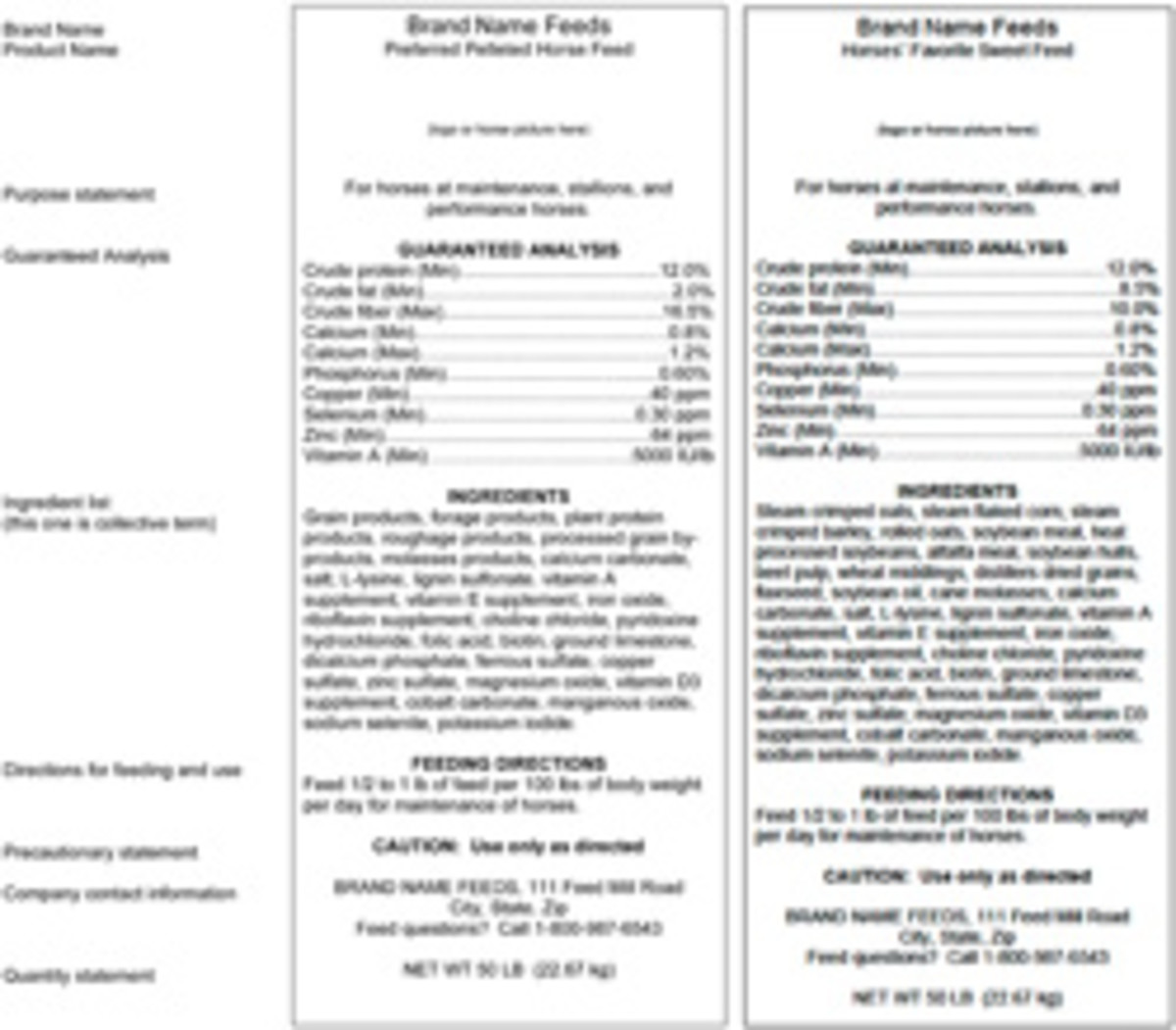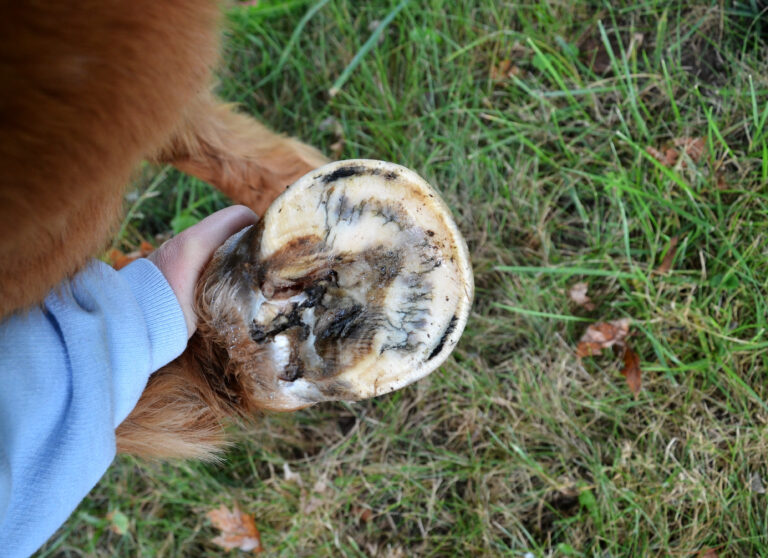Is your horse getting the nutrition he needs from his feed? If you give him a commercial concentrate, the answer to that question is on the feed bag. Commercial feed labels provide specific information, and interpreting them isn’t as difficult as it may seem at first glance. This article (and the sample feed labels) will tell you how to decode what you see when you read between the lines.

Commercial feed labels follow a format set by the Association of American Feed Control Officials, whose members are state and federal feed regulators. The label must include the following information:
- the feed name
- the purpose or use of the feed
- a guaranteed analysis of the nutrients in the feed
- a list of ingredients
- directions for feeding and use
- the name and address of the manufacturer
- the net weight of the bag
- a list of drugs if the feed is medicated
- any precautions or warnings.
AAFCO regulators test commercial feed mixes before they’re marketed and at random times thereafter, so you can be reasonably confident that the information is accurate.
There are two types of labels: The label on the left has a collective-term ingredient list–it uses general terms for the ingredients, which gives the manufacturer some flexibility to change the recipe slightly, as long as it doesn’t change the guaranteed analysis. The label on the right has a fixed-formula ingredient list?it lists each ingredient by name, which may be beneficial if your horse has an allergy or sensitivity. Each format has its own advantages, and one is not better than the other. All feed labels must list a brand and product name, purpose, guaranteed analysis, ingredient list, directions, precautions, contact information and quantity.
Name
This is usually a term describing the type or form of feed.
- Processed feeds: The ingredients are ground up, cooked and formed into pellets or extruded nuggets (which are puffed up like Rice Krispies).
- Mixed grain, textured feed and sweet feed are grain mixtures with added molasses. This feed and the one above are meant to complement forage such as hay and grass.
- Complete feeds are all-in-one combinations of concentrates and forage, although they don’t supply the same long-stemmed fiber as hay and grass.
Purpose Statement
This tells you not only that the feed is for horses but also the classes (life stages and performance levels) it’s intended for. A feed might be labeled “for growing foals” or “for maintenance of mature horses,” for example. Horses are considered at “maintenance” when they are doing little or no work.
Between the lines: When a feed is a mix labeled for horses of a certain class, then it must be nutritionally balanced for those horses. That is, regulations require that the feed meet the minimum nutritional requirements for those horses–if fed according to directions on the label. AAFCO officials test it to make sure that it does meet the requirements, and to ensure quality and safety. In addition, the horse feed manufacturer must sign an affidavit of suitability stating that it has knowledge of the nutritional content of the feed and the nutritional requirements for the classes listed on the label. (The requirements follow the recommendations published by the National Research Council.)
Plain grains (such as 100-percent rolled oats) are not balanced for horses. Nor, obviously, are multi-purpose livestock feeds or feeds labeled for other animals. But if you buy a commercial feed labeled for, say, broodmares, and feed it according to the directions, it will meet the nutritional requirements of your broodmares.
Guaranteed Analysis
Here you’ll find a breakdown of nutrients provided by the feed, as determined by laboratory testing. Regulations require the list to include certain nutrients; manufacturers can list others if they choose.
Crude protein: Commercial horse feeds typically contain at least 8 percent to 16 percent crude protein, with feeds formulated for maintenance of mature horses at the low end of the range and those for growing horses and broodmares that are lactating or in the last three months of pregnancy at the high end.
Between the lines: Horses need protein to maintain and develop muscle, to produce enzymes and hormones, and for other body functions. The kind of protein matters, too. Proteins are made up of chains of amino acids, and the arrangement of the amino acids in these chains determines the type of protein. Some amino acids must be obtained in the diet; they’re termed essential. Others are made by the body.
One essential amino acid, lysine, is critical for growth and muscle repair and may be the most important for horses. Lysine is often listed in the guaranteed analysis on the feed label. If it’s not, check the ingredients. Soybean meal, a common protein source in horse feeds, is rich in lysine.
Crude fat: Fat is a dense source of energy. Per pound, it provides more than twice as much digestible energy as protein or carbohydrates. The label shows the minimum level of crude fat, which may be anywhere from less than 2 percent to 8 percent or more. High-fat feeds generally provide more high-octane fuel–more energy–for the horse.

Between the lines: You won’t find anything comparable to the calories-per-serving number on packaged foods at the supermarket anywhere on your horse’s feed label. That’s because there’s no simple way to get the information on the total digestible energy that the feed provides. To calculate digestible energy, you need to first measure the total energy content of the feed; then feed some to horses long enough for their systems to adjust (usually two weeks); then collect all of the manure passed; and finally burn the manure, to measure the undigested, excreted energy. (Being a horse nutritionist is not all glamour!) Total energy minus energy excreted is digestible energy–but the number varies with a horses’, breed, body type, health, teeth and so on.
But fat content gives you one indication of the digestible energy level–the higher the percentage of fat, the higher the amount of digestible energy in the feed. For another yardstick of digestible energy, check the fiber content.
Crude fiber: Most forms of fiber provide low amounts of energy, but fiber is essential to keep the digestive system working smoothly. The label shows the maximum percentage of crude fiber, typically 7 percent to 12 percent. A high-fiber feed might have more.
Between the lines: Feeds that are lower in fiber are generally more digestible; so, the lower the fiber, the higher the digestible energy.
Minerals and vitamins: Levels of important minerals–calcium, phosphorus, copper, zinc and selenium–are shown as maximum or minimum percentages or in parts per million (ppm). Vitamin A is shown in International Units (IU) per pound. Manufacturers may choose to list other vitamins and minerals, but they aren’t required to.
Between the lines: Grains used in horse feeds, such as oats, corn and barley, are high in phosphorus and low in calcium, copper and zinc. Horses need these minerals in the right quantities and proportions, so feed formulators add mineral supplements (depending on what the feed contains naturally) to balance the feed.
- Calcium and phosphorous: Horses need them in the right ratio — between 1.1 and 2 parts calcium to 1 part phosphorus in the total ration, meaning everything that the horse is eating, both grain and hay. Alfalfa and other legume hays generally have more calcium than grass hays, so some feeds are specifically balanced to complement certain hays. You’ll find this information in the feeding directions section.
- Calcium, copper, and zinc are especially important for growth and development; feeds for young horses and pregnant mares generally contain higher levels.
- Selenium is a key mineral, but it also can be toxic–so it’s important not to overfeed it. When selenium is added to grain, then, you should avoid feeding a supplement that also contains it.
- Vitamin A (beta carotene) is ample in green pasture grass. But it’s often added to feed because most horses don’t have year-round access to green grass, and levels in hay vary widely.
Some people dilute commercial mixes with straight grain, such as oats, because they think that the mix is “too rich” or that they’ll save money this way. Neither is true. Adding plain grains to a commercial mix changes the overall quantity and proportion of minerals that the horse gets, so his feed is no longer balanced.
Ingredients
This section tells you what’s actually in the feed. Ingredients are listed in order of amount, from greatest to least, in one of two formats — fixed-formula or collective term. A fixed-formula list states specific ingredients (such as steam-flaked corn, rolled oats, soybean meal and so on), and the manufacturer must use the same ingredients in the formulation as long as that label is used. A collective-term list uses general terms defined by AAFCO, such as grain products, forage products, plant protein products and processed grain byproducts.
Between the lines: Both formats have their advantages, and one is not necessarily better than the other.
- With a fixed ingredient list, you know exactly what’s in the feed. This is important if your horse has an allergy or sensitivity to certain ingredients or if you simply have a preference. But you may find that the price of this feed fluctuates. If “steam-flaked corn” is listed ahead of other grains, the manufacturer must use more steam-flaked corn than any other ingredient regardless of rising corn prices. That may mean a price increase for you.
- A collective-term list gives manufacturers some flexibility. If “grain products” is first on the list, they can reformulate slightly to include less corn and more rolled oats, say–as long as the change does not affect the guaranteed analysis. This may save you some money.
Feeding Directions
The feeding directions suggest the amount to be fed daily, based on your horse’s weight. They generally give a fairly broad range (for example, ? pound to 1 pound of feed per 100 pounds of body weight); exercise level and individual metabolism determine where in that range each horse falls. The directions often include recommendations on feeding management and the type of forage the feed will complement.
Between the lines: A balanced feed provides all the nutrients your horse needs only if it’s fed according to the directions. Here are some key points:
- You need to know your horse’s weight (or at least estimate it with a weight tape) to calculate the manufacturer-recommended ration.
- You need to measure his feed by weight, not volume. A quart of extruded feed may weigh 40 percent less than a quart of pelleted feed and provide 40 percent less nutrition, even if both provide the same nutrition pound for pound.
- Doing the math may help you save money. You may find, for example, that a $15 bag of feed is cheaper than a $12 bag. Suppose the $12 feed requires feeding ? pound per 100 pounds of body weight and your horse weighs 1,200 pounds. He needs 8 pounds of the feed a day, which costs $1.92. If the $15 feed requires feeding ? pound per 100 pounds of body weight, he’ll need 6 pounds a day — at a cost of $1.80.
What if good-quality hay and pasture alone provide enough calories for your horse to maintain or even gain weight, so even the minimum recommended amount of feed would make him too fat? In this case, his ration may be short on some key nutrients, mainly protein and important minerals. (A common symptom of protein deficiency in adult horses is coprophagy, or eating manure. Foals eat manure for a different reason–to populate their intestines with bacteria and microbes needed to digest fiber.)
A balanced supplement with protein, vitamins and minerals in a more concentrated form can give your “easy keeper” horse the nutrients he needs in, say, 4 ounces instead of 4 pounds. Be sure to feed the supplement exactly as recommended and not in group feeding situations where one horse might get the lion’s share.











